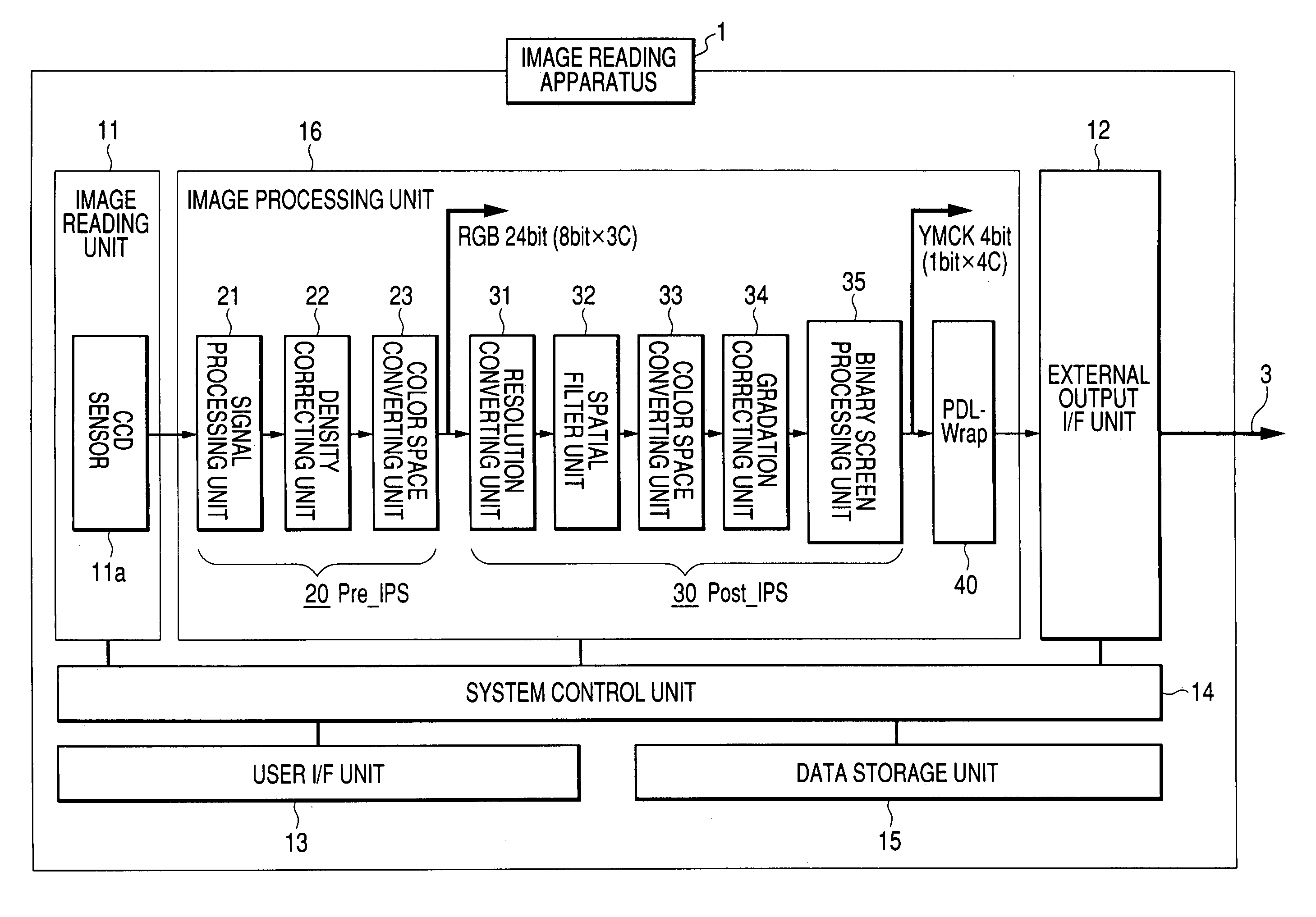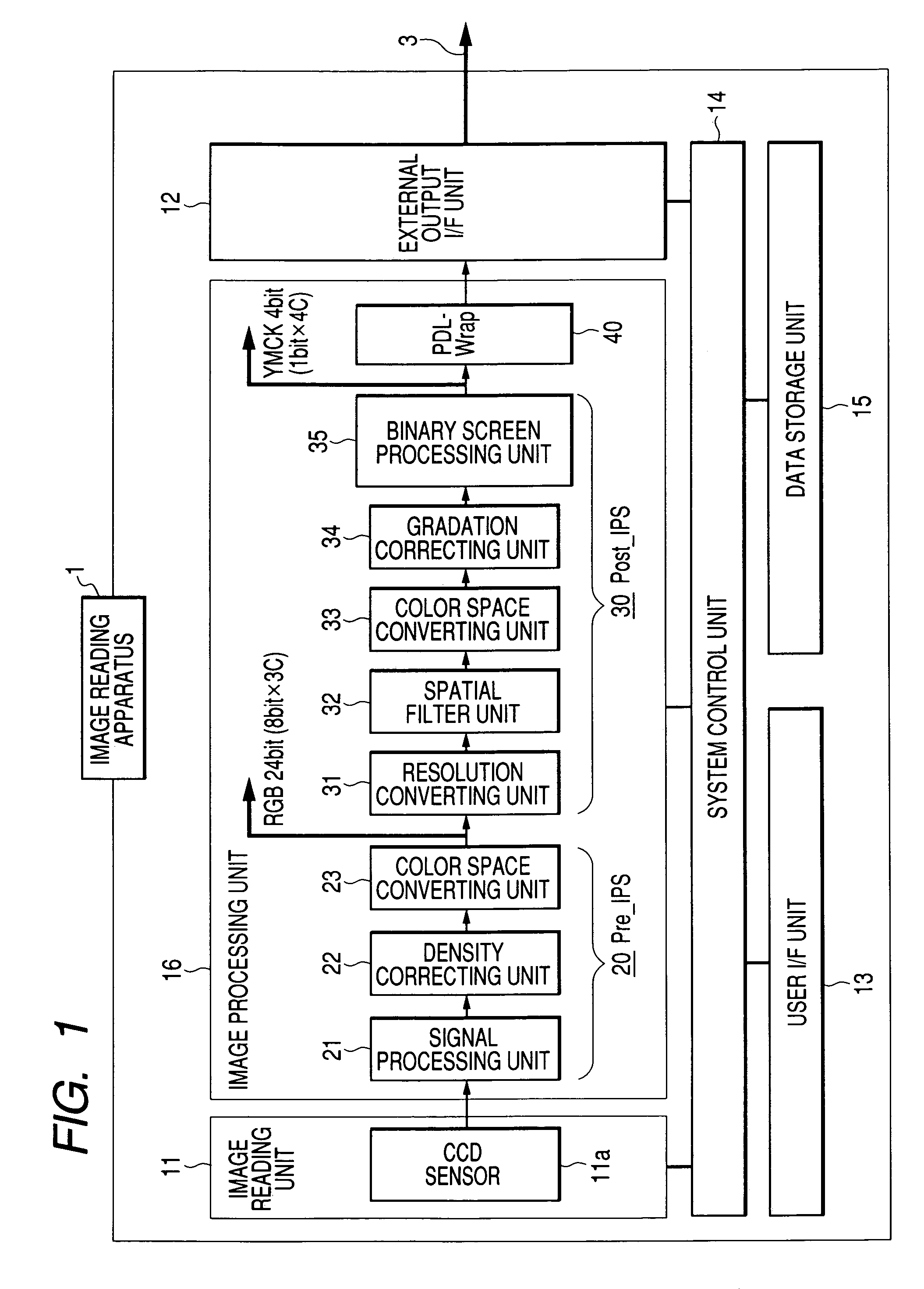Image reading apparatus
a reading apparatus and image technology, applied in the direction of digital output to print units, instruments, digitally marking record carriers, etc., can solve the problems of blurred characters, image quality problems, multi-valued data that are read by the image reading apparatus and not necessarily intended for printing, etc., to achieve high-quality printouts, reduce image data output load of the image output apparatus, and reduce the effect of data amoun
- Summary
- Abstract
- Description
- Claims
- Application Information
AI Technical Summary
Benefits of technology
Problems solved by technology
Method used
Image
Examples
embodiment 1
[0019]First, a first embodiment of the invention will be described. FIG. 1 is a block diagram showing a general configuration of the image reading apparatus according to the invention. FIGS. 2A and 2B are block diagrams showing system configurations according to a first embodiment of the invention.
[0020]First, the system configuration using the image reading apparatus will be described. As shown in FIG. 2A, the system being described is equipped with the image reading apparatus 1, an image output apparatus 2, and a communication channel 3 that connects the image reading apparatus 1 and the image output apparatus 2.
[0021]The image reading apparatus 1, which is a scanner, for example, optically reads an image on an original document as a subject of reading. The image reading apparatus 1 is not limited to a scanner, and may be a copier having a scanner function or what is called a multifunction machine having a copier function, a printer function, and a facsimile function as long as it...
embodiment 2
[0060]Next, a second embodiment of the invention will be described. Only differences from the first embodiment will be described. FIGS. 4A and 4B are block diagrams showing system configurations according to the second embodiment of the invention.
[0061]For example, as shown in FIG. 4A, an image reading apparatus 1 according to this embodiment is used in a system configuration that is different than in the first embodiment. In the first embodiment, the image reading apparatus and the image output apparatus 2 are directly connected to each other according to USB 2.0, for example. However, the invention is not limited to such an image reading apparatus 1. As described in this embodiment, the image reading apparatus 1 may be network-connected. For example, the image reading apparatus 1 may be connected to image output apparatus 2 via a network 5 that enables wired or wireless communications. In this case, it is assumed that not only the image reading apparatus 1 and the image output app...
embodiment 3
[0069]Next, a third embodiment of the invention will be described. Only differences from the first or second embodiment will be described. FIGS. 5A and 5B are block diagrams showing a system configuration according to the third embodiment of the invention.
[0070]In the first embodiment, as shown in FIG. 5A, the image reading apparatus 1 incorporates the data storage unit 15 and output characteristics data that are acquired by uploading from the image output apparatus 2 are stored in the data storage unit 15. The storage of the output characteristics data by the data storage unit 15 may be either temporary or permanent.
[0071]In contrast, in this embodiment, as shown in FIG. 5B, output characteristics data that are acquired by uploading from the image output apparatus 2 are stored in an external apparatus rather than a unit in the image reading apparatus 1. It is assumed that in addition to the image output apparatus 2 the external apparatus is connected to the image reading apparatus ...
PUM
 Login to View More
Login to View More Abstract
Description
Claims
Application Information
 Login to View More
Login to View More - R&D
- Intellectual Property
- Life Sciences
- Materials
- Tech Scout
- Unparalleled Data Quality
- Higher Quality Content
- 60% Fewer Hallucinations
Browse by: Latest US Patents, China's latest patents, Technical Efficacy Thesaurus, Application Domain, Technology Topic, Popular Technical Reports.
© 2025 PatSnap. All rights reserved.Legal|Privacy policy|Modern Slavery Act Transparency Statement|Sitemap|About US| Contact US: help@patsnap.com



